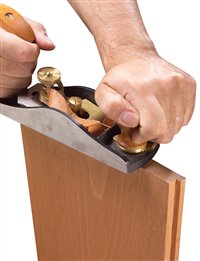We may receive a commission when you use our affiliate links. However, this does not impact our recommendations.
Q & A: Low-Angle Planes
Provide
Versatility
Q:
What advantage does a low-angle
bench plane have over a standard
bench plane?
A:
Low-angle bench planes allow you to
change the blade’s effective cutting
angle to suit specific tasks. Because the bevel
points up on a low-angle plane, the effective cutting
angle can be varied based on the iron’s bevel
angle. The bevel-up configuration also means the
plane blade is fully supported right up to the cutting
edge. With the bevel down, the cutting edge
remains unsupported along the bevel, which can
lead to blade chatter (Fig. A, below).
To get the most out of your low-angle bench
plane, it’s best to have two or three blades on hand
with various bevel angles already ground on them
(Fig. A). A 25-degree bevel ground on the cutting
iron will produce a low cutting angle of 37 degrees
that’s ideal for shaving end grain (see photo, above). A
35-degree bevel approximates the 45-degree cutting
angle on a standard bench plane, which is best-suited
for general planing tasks. A 50-degree bevel creates a
high cutting angle of 62 degrees for more of a scraping
cut that reduces tearout on squirrelly grained
wood, such as bird’s-eye maple.
Click any image to view a larger version.
Fig. A: Exploded View
The cutting angle is simply the sum of the bevel angle
and the plane-bed angle or pitch. The pitch of a low-angle
bench plane is 12 degrees, but its effective cutting angle
can be varied based on the iron’s bevel angle. Standard
bench planes usually have a pitch of 45 degrees, often
referred to as common, or York, pitch. Since the plane
is bevel down, the effective cutting angle remains at
45 degrees no matter what angle is ground on the bevel.
|
This story originally appeared in American Woodworker December/January 2007, issue #126. |
|
Here are some supplies and tools we find essential in our everyday work around the shop. We may receive a commission from sales referred by our links; however, we have carefully selected these products for their usefulness and quality.











